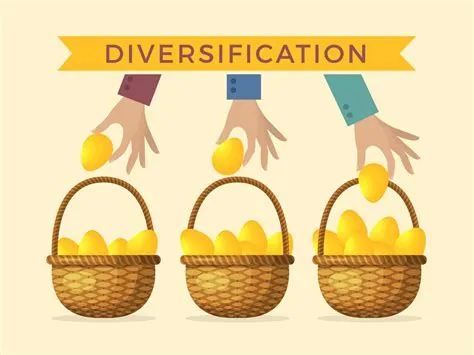Hey there, fellow micro-investing-risks">micro-investing-platforms">micro-investing-basics">micro-investors! Let’s talk about something super important: diversification. Think of your investments like a delicious, nutritious meal. You wouldn’t just eat one type of food, right? You need a mix of proteins, carbs, fruits, and veggies to get all the nutrients your body needs. The same principle applies to your investments! Diversification isn’t just a fancy finance term; it’s your secret weapon to build a strong and resilient financial portfolio, even if you’re working with a smaller budget.
So, what does diversification actually mean? Simply put, it’s spreading your investment money across different assets to reduce risk. Imagine putting all your eggs in one basket – if that basket falls, you lose everything. Diversification is like having several baskets, each holding a different type of egg. Even if one basket breaks, you still have eggs left!
But how do you diversify when you’re a micro-investor with limited funds? Don’t worry; it’s totally achievable! Here are some practical tips tailored for those of us working with smaller amounts:
1. Embrace the Power of fractional shares:
Remember those days when investing felt like a millionaire-only club? Not anymore! Platforms now allow you to buy fractional shares of stocks, meaning you don’t need to buy a whole share at once. This opens the door to investing in high-priced companies you might have previously deemed out of reach. It’s like getting a slice of a giant pizza instead of having to buy the whole thing – affordable and satisfying!
2. Explore Exchange-Traded Funds (ETFs):
ETFs are like diversified baskets themselves! They bundle together multiple stocks or bonds, offering instant diversification with just one purchase. Think of it as a delicious, pre-made salad – you get a variety of ingredients without having to chop and mix everything yourself. Many ETFs cater to specific sectors or market segments, allowing you to target your investment interests effectively.
3. Don’t Forget Bonds:
While stocks offer the potential for higher returns, they also carry more risk. Bonds generally provide stability and a steady income stream, acting as a counterbalance to the volatility of stocks. It’s like having a reliable savings account alongside your exciting entrepreneurial ventures. They offer a cushion during market downturns, providing a sense of security in your overall portfolio.
4. Consider Asset Allocation:
Asset allocation is about strategically dividing your investments among different asset classes like stocks, bonds, real estate (even if it’s just a small contribution to a REIT), and potentially other alternatives like commodities or precious metals if you’re comfortable with the higher risks associated with them. This isn’t about picking individual stocks; it’s about deciding the proportion of your portfolio dedicated to each asset class. This requires some research and self-assessment to determine your risk tolerance and financial goals. A good starting point is online asset allocation calculators that can help you decide based on your age and investment timeline.
5. Robo-Advisors: The Automated Approach:
Short on time or unsure where to begin? Robo-advisors offer automated investing based on your risk profile and goals. They handle the diversification for you, creating and managing a portfolio based on your input. Think of it as having your own personal financial chef who prepares a customized investment meal just for you, even without requiring you to spend a lot of time in the kitchen.
6. Dollar-Cost Averaging (DCA):
This strategy involves investing a fixed amount of money at regular intervals, regardless of market fluctuations. By consistently investing, you avoid the risk of investing a lump sum at a market peak. It’s like making small, regular contributions to your savings account—consistent and reliable.
7. Reinvest Your Dividends and Interest:
When your investments generate dividends or interest, consider reinvesting them to increase your overall holdings and accelerate growth. It’s like letting your money work harder for you. This is a powerful compounding effect that enhances your investment returns over time.
8. Stay Informed (But Not Overwhelmed):
Keeping up with market trends is important, but avoid getting bogged down in daily market noise. Focus on the long-term growth potential of your investments. It’s like enjoying a scenic hike instead of sprinting frantically to your destination. Consistent progress is more important than a fast-paced, turbulent journey.
9. Regularly Review and Rebalance:
Life changes, and so should your investment strategy. Regularly review your portfolio to ensure it still aligns with your goals and risk tolerance. Rebalancing involves adjusting your asset allocation to maintain your desired mix. This ensures you’re not inadvertently taking on more risk than you’re comfortable with. It’s like checking your garden to see if plants need more water or sunlight to thrive.
10. Start Small, Stay Consistent:
You don’t need a massive amount of money to start diversifying. Even small, consistent investments can grow significantly over time. Consistency is key to building wealth. Think of it as planting a small seed that grows into a strong tree over time.
Diversification is a marathon, not a sprint. It’s a journey that requires patience, discipline, and a long-term perspective. By following these tips, you’ll be well on your way to building a robust and diversified investment portfolio, regardless of the size of your initial capital. Remember, every small step counts, and you are in charge of your financial journey!
Conclusion:
Building a diversified investment portfolio as a micro-investor is entirely achievable. By understanding the fundamentals of diversification and employing strategies like fractional shares, ETFs, and dollar-cost averaging, you can mitigate risk and set yourself up for long-term financial success. Remember, it’s a journey, not a race. Start small, stay consistent, and watch your investments grow.
FAQs:
1. What is the minimum amount I need to start diversifying my investments? There’s no magic number. Many brokerage platforms now allow you to invest with very small amounts, even just a few dollars.
2. How often should I rebalance my portfolio? A good rule of thumb is to rebalance once or twice a year, or whenever your asset allocation deviates significantly from your target allocation.
3. Are robo-advisors suitable for all investors? While robo-advisors offer convenience, they may not be the best fit for everyone. If you enjoy managing your own investments and prefer a hands-on approach, you might prefer traditional brokerage accounts.
4. What are the risks associated with investing in ETFs? While generally considered lower-risk than individual stocks, ETFs are still subject to market fluctuations and can lose value.
5. Can I diversify my investments across different countries? Yes, international diversification can further reduce risk, but it also introduces currency risk and requires a deeper understanding of global markets.

